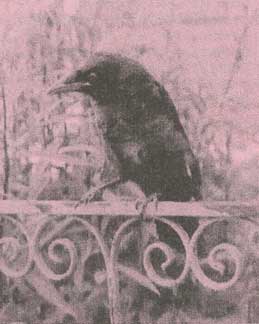Wildlife on Round Hill
by Rob Stephenson (Upper Lewes Road) Round Hill Reporter September 2003
 The young crow pictured on a garden fence had recently taken its maiden flight from one of the few elms left in the Upper Lewes Road, and seemed to decide that was enough flying for a while. The same tree has attracted up to three grey squirrels, which get there across our roof and one mighty leap. At this time of year they have so much energy it’s amazing to watch them play vertical hide and seek in the tree, often whilst shoppers pass below oblivious of the treetop action.
The young crow pictured on a garden fence had recently taken its maiden flight from one of the few elms left in the Upper Lewes Road, and seemed to decide that was enough flying for a while. The same tree has attracted up to three grey squirrels, which get there across our roof and one mighty leap. At this time of year they have so much energy it’s amazing to watch them play vertical hide and seek in the tree, often whilst shoppers pass below oblivious of the treetop action.
All that activity needs fuel, and they are regular visitors to the back garden medlars, rose hips and crab apples.
I’ve yet to see the squirrels try apples or blackberries, unlike the pair of blackbirds and their two offspring which seem to spend all their time eating the riper bits out of apples on our trees, and leaving blackberry stained droppings on our washing. The blackbird family has reached an interesting stage where they travel together half the time, and the rest of the time the adults chase their young away.
On 9th August, high in the sky six swifts wheeled and screamed, whilst at first floor height a pair of large dragonflies quartered the air with apparent geometrical precision – both seeking insects. The swifts, adults and this year’s young, will soon be leaving for Africa but the large blue and black dragonflies are probably Migrant Hawkers – forced out of northern France by a population boom as adults emerged from ponds and lakes, and are just feeding whilst passing through Round Hill looking for bigger ponds than we can offer to lay their eggs.
They say there is a massive decline in House Sparrows, but a flock of nine adults and young has been working our back gardens for a couple of weeks now, seeking insects in shrubs, trees and gaps in walls and between roof tiles. One of them seemed far to slim and elegant to be a sparrow, and a closer look revealed that a Willow Warbler (or a Chiff Chaff – I certainly can’t tell them apart) had joined the flock.
This page was last updated by Ted on 09-Nov-2013
 The young crow pictured on a garden fence had recently taken its maiden flight from one of the few elms left in the Upper Lewes Road, and seemed to decide that was enough flying for a while. The same tree has attracted up to three grey squirrels, which get there across our roof and one mighty leap. At this time of year they have so much energy it’s amazing to watch them play vertical hide and seek in the tree, often whilst shoppers pass below oblivious of the treetop action.
The young crow pictured on a garden fence had recently taken its maiden flight from one of the few elms left in the Upper Lewes Road, and seemed to decide that was enough flying for a while. The same tree has attracted up to three grey squirrels, which get there across our roof and one mighty leap. At this time of year they have so much energy it’s amazing to watch them play vertical hide and seek in the tree, often whilst shoppers pass below oblivious of the treetop action. All that activity needs fuel, and they are regular visitors to the back garden medlars, rose hips and crab apples.
I’ve yet to see the squirrels try apples or blackberries, unlike the pair of blackbirds and their two offspring which seem to spend all their time eating the riper bits out of apples on our trees, and leaving blackberry stained droppings on our washing. The blackbird family has reached an interesting stage where they travel together half the time, and the rest of the time the adults chase their young away.
On 9th August, high in the sky six swifts wheeled and screamed, whilst at first floor height a pair of large dragonflies quartered the air with apparent geometrical precision – both seeking insects. The swifts, adults and this year’s young, will soon be leaving for Africa but the large blue and black dragonflies are probably Migrant Hawkers – forced out of northern France by a population boom as adults emerged from ponds and lakes, and are just feeding whilst passing through Round Hill looking for bigger ponds than we can offer to lay their eggs.
They say there is a massive decline in House Sparrows, but a flock of nine adults and young has been working our back gardens for a couple of weeks now, seeking insects in shrubs, trees and gaps in walls and between roof tiles. One of them seemed far to slim and elegant to be a sparrow, and a closer look revealed that a Willow Warbler (or a Chiff Chaff – I certainly can’t tell them apart) had joined the flock.